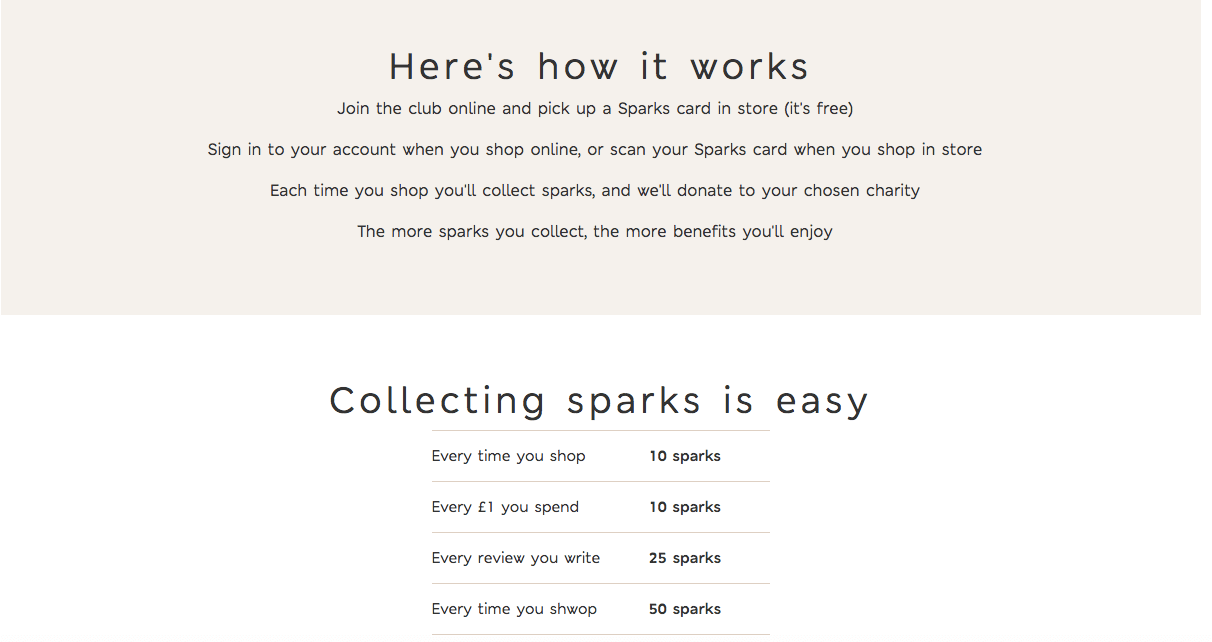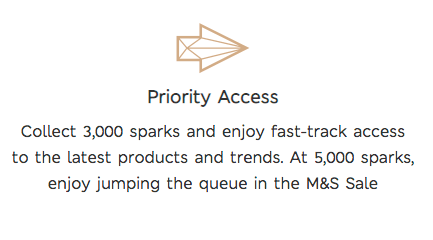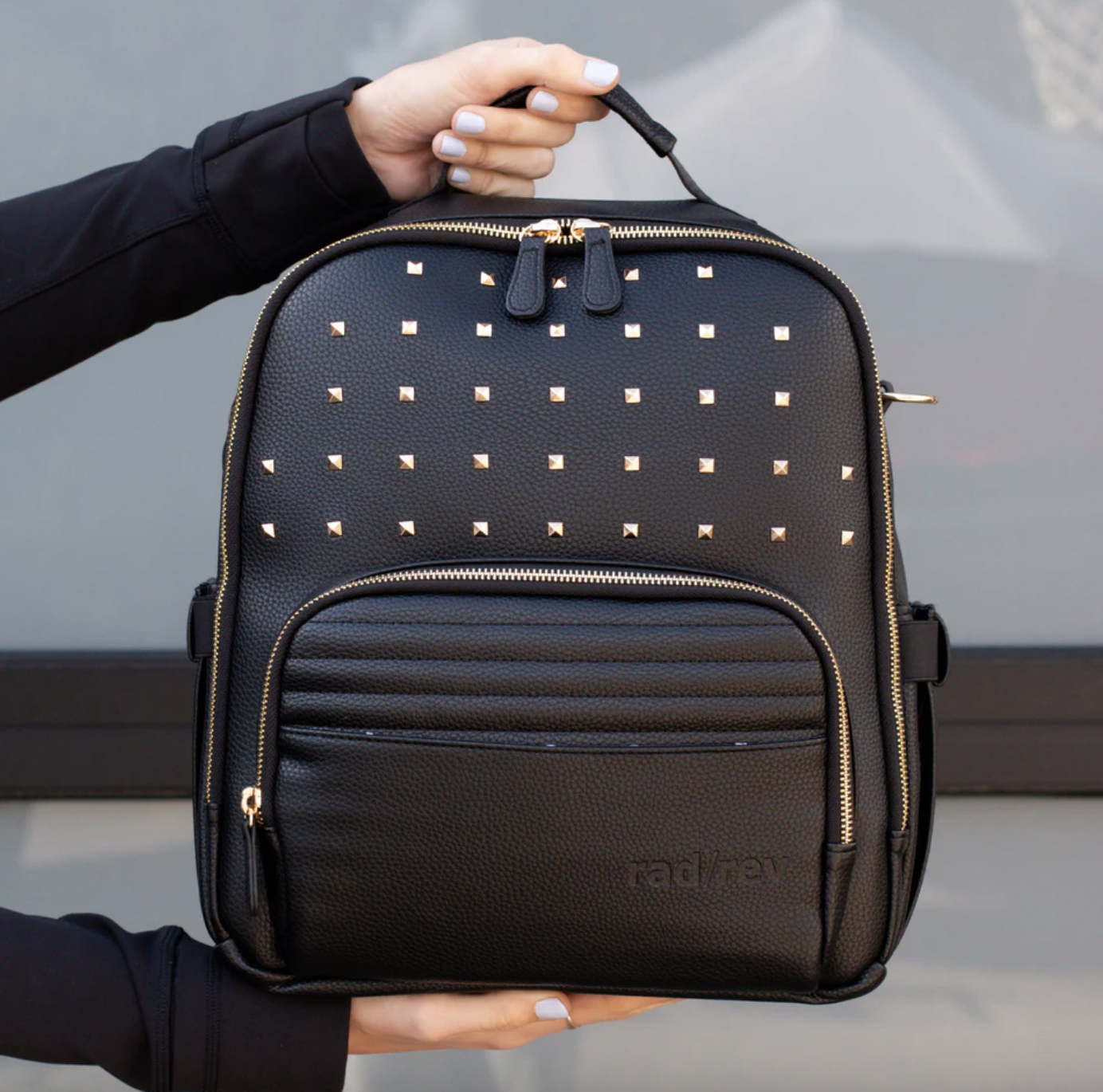If you’ve ever travelled across the pond to the UK, odds are you’ve come across Marks & Spencer (M&S). Established over 100 years ago, their retail stores are known for being a one stop shop for almost any home goods - not unlike Walmart or Target in North America.
As a household brand in the United Kingdom that straddles a variety of markets (clothing, grocery, home), they have the reach and potential to create a valuable and rewarding brand community for their loyal customers.
That’s where their Sparks rewards program comes in. However, does this rewards program live up to the legacy of the Marks & Spencer name? Let’s find out!
How Sparks rewards lights the way
Since Marks and Spencer is synonymous with convenience and having everything you need, it’s no wonder the Sparks program tries to be the same way. It has a number of great features that make it easily accessible to new shoppers while still offering lots of value to existing community members.
Easy-to-understand earning rules
One of the greatest parts of the Sparks program is how easy it is for customers to see how they earn points. A lot of rewards program explainer pages get this wrong and attempt to make earning rules too fancy. This makes them hard to understand and can lead customers to assume the program is complicated.

Marks & Spencer breaks this trend by clearly outlining how many sparks members earn for making a purchase or completing other earning actions. This makes it easy to connect the value of completing actions to the value of joining, increasing a new customer’s desire to join.
Showing customers what’s in it for them is a huge part of what draws them into your brand community. When customers understand what you’re offering and see that you’ll deliver, they’re more excited to be a part of it. The Sparks program does this by quickly showing customers what they stand to earn, ensuring they will take the time to join the Sparks community.
Easily achieved VIP tiers
One of the best things about VIP programs is the feeling of joy and achievement that come with working your way up through the levels. When you can see your progress, you’re much more likely to be motivated to keep engaging over time. However, these elements of gamification can’t be unlocked if members struggle to move up through the different levels.
With that in mind, the Sparks program has set very achievable thresholds for members to move up VIP tiers within just a couple of purchases.

With their 10 sparks per pound conversion rate, their 3,000 and 5,000 spark tiers are achieved at £300 and £500 respectively. While this might seem high, think about how much you spend on groceries per month. It would take only a couple large purchases, not to mention all the other clothing and home items you could buy there!
Creating achievable initial tiers motivates customers to spend just a bit more to reach the next level, moving them up the ranks of the Spark program. We all love the thrill of accomplishing something, so VIP tiers that tap into that desire are great for motivating Sparks community members to stay engaged over time.
Creates emotional connections through social causes
One of the best parts of the Sparks program is its connection to social causes. Even before the program existed, M&S made giving back a part of their corporate identity through what they call “shwopping”. The idea behind shwopping is that every time you buy a new article of clothing, you should get rid of something you currently own.

Marks & Spencer made this easy by installing shwop drop bins at each of their stores. M&S then takes all the donated clothes and gives it to Oxfam, a non-profit that uses the clothes as part of their fight to end global poverty.
To make this experience a valuable part of the Sparks program, Marks and Spencer gives members 50 sparks every time they shwop, making it the most valuable earning action in the Sparks rewards program. On top of that, every time Sparks members make a purchase, M&S makes a very small donation of 1p (roughly 1 cent) to charity. Even though this is a small gesture, knowing M&S processes tens of thousands of transactions per day illuminates how these small actions can really add up!

These connections to charitable causes goes a long way towards building an inclusive and inviting brand community. By tying their brand to doing good and having a positive global impact, M&S helps members form emotional connections with their brand.
These emotional connections then become a powerful switching barrier that keeps them invested in the community. After all, why would their customers shop somewhere else when they know their involvement in the M&S brand community has such a positive social impact?
When you consider that 87% of customers are willing to buy products based on a brand’s advocacy, it’s easy to understand why shwopping is such an important part of their rewards experience.
Where Marks & Spencer Sparks Rewards fizzles
While there are many great things about the Sparks program, it isn’t all sunshine and rainbows. There are a few areas that the program could improve in order to really delight its members and motivate others to join the community.
Non-accelerated earning makes higher tiers daunting
Even though it’s awesome that the lower tiers are easily attainable, things start to get dicey once members move past those and set their sights on higher tiers.

After reaching the 5000 spark tier, customers need to have earned a whopping 14,000 sparks in total before levelling up.
While this is technically doable, it’s also very demotivating and daunting for members facing the huge jump between the 5k and 14k tiers. In fact, it wouldn’t surprise me if shoppers opt not to join the program because of the perceived struggle of bridging that gap. Adding accelerated earning would lower that barrier to entry and make every stage of the program look and feel more valuable.
Tier descriptions aren't accurate
When you first land on the Sparks program explainer page, it seems like there are 5 different VIP tiers: an initial tier, and then new tiers achieved after earning 3k, 5k, 14k, and 17k sparks. However, this isn’t actually true. When you dig into the FAQ page, it shows that there are actually 8 tiers, not 5.

These three additional tiers suddenly make it much more attainable to move up through the ranks of the program. The problem is, customers would need to go looking for this information to get clarification.
Not properly explaining how their program works is a huge issue for demotivating customers to join and keeping them engaged once they’ve joined. If customers think they need to spend £900 to reach the next tier, the chances of them switching to one of M&S’s competitors is significantly higher.
Creating a more user friendly explainer page would show customers the value of each tier. Knowing all the possible tiers, what needs to be achieved to reach each one, and the perks earned at each step will show members the total value of the Sparks program as part of the M&S brand community.
Does M&S Sparks make it’s member’s lives brighter?
After looking at the program as a whole, it’s clear that M&S tried to design Sparks with their customers in mind. With lots of ways for members to earn and redeem the sparks they earn and a clear connection to social causes, it most certainly comes across as a valuable community to join.
However, when you’re one of the top retailers in the country, you have to know that there will be eyes on everything you do. With that in mind, it is surprising that the poor program description and confusion about how the program actually works has flown under the radar for so long.
The Sparks program might be rewarding, but M&S needs to better explain the value of each tier so customers will be more enticed to join and engage with the program beyond the initial tiers. Otherwise, the Sparks program might be destined to be just a flash in the pan.







